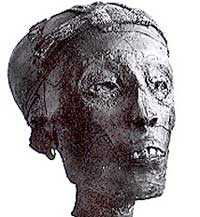Egypt to put Tutankhamun mummy on display in tomb
 EGYPT will put the mummy of the boy pharaoh Tutankhamun on display next month inside his tomb in Luxor's Valley of the Kings, allowing visitors to see his face for the first time, Egypt's chief archaeologist said overnight.
EGYPT will put the mummy of the boy pharaoh Tutankhamun on display next month inside his tomb in Luxor's Valley of the Kings, allowing visitors to see his face for the first time, Egypt's chief archaeologist said overnight.
Zahi Hawass, head of the High Council for Antiquities, said he would place the mummy in a climate-controlled glass showcase in the tomb and cover the body with linen. Tutankhamun's bare face would be visible.
"You will enter the tomb and see for the first time the face of Tutankhamun ... This is the first time in history that anyone will see the mummy (in public). This will continue the magic of Tutankhamun," Mr Hawass said.
Tutankhamun, who died on the cusp of adulthood, ruled Egypt between about 1361 and 1352 BC. The 1922 discovery of his intact tomb, whose treasures included a now famous gold funerary mask, stunned the archaeological community.
Although the artefacts from Tutankhamun's burial tomb have toured the world, the mummified body of the king has been examined only a handful of times in detail since the tomb was discovered by British archaeologist Howard Carter.
Mr Hawass said Tutankhamun's mummy was currently resting in a sarcophagus inside the tomb covered by a gilded coffin, but that the humidity caused by the breathing of thousands of visitors threatened to damage it.
"I thought that this will help tourists and at the same time help preserving the mummy. I think a mummy like this, the golden boy, it is time that people should really see it," he said.
Tutankhamun came to the throne shortly after the death of Akhenaten, the maverick pharaoh who abandoned most of Egypt's old gods in favour of the Aten sun disc and brought in a new and more expressive style of art.
During Tutankhamun's reign, advocates of the old religion were regaining control of the country and turning their backs on Akhenaten's innovations.
Tutankhamun was buried along with many other pharaohs of the period in the Valley of the Kings near the modern town of Luxor.
Mr Hawass had not yet set a date to display the mummy, but said he expected it to be shortly before a mid-November exhibit on Tutankhamun in London that is to include the pharaoh's royal crown but not the gold mask, which is too delicate to travel.
Mr Hawass described Tutankhamun as having "buck teeth" and pictures of the mummy show a face with high cheekbones and blackened, cracked skin and an intact nose.
Mr Hawass was also planning to shortly open 16 jars from Tutankhamun's tomb that were rediscovered in a storage area in Luxor. The jars were originally found by Carter but were forgotten about over the years.
He said he expected the jars would contain food, grain, beer and wine, items the king would have been expected to need in his afterlife. The jars were part of caches of artefacts whose rediscovery was announced last month.
Mystery has surrounded Tutankhamun ever since 1922. Lord Carnarvon, Carter's sponsor and among the first to enter the tomb, died shortly afterward from an infected mosquito bite.
Newspapers at the time said Carter had unleashed a pharaonic curse that killed Carnarvon and others linked to the discovery.
Scientists have in the past suggested a disease lying dormant in the tomb may have killed the British aristocrat.






